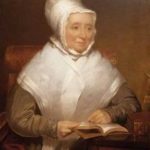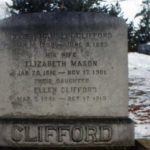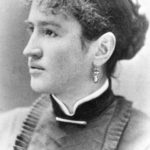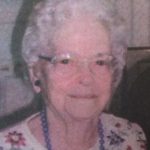Mar 1, 2022
March is National Women’s History Month—a time when we recognize the contributions and accomplishments of women through the ages. We thought it only fitting that we should recognize some of Medfield’s extraordinary women.
 Hannah Adams (1755-1831) is undoubtedly Medfield’s most famous woman. An early American historian and pioneer in the field of comparative religion, she was also the first American author to make a living solely from writing. She was the first to attempt to represent sects and denominations from their own perspective using their own words. Her dispute with the Rev. Jedidiah Morse, an orthodox Calvinist, over publication rights for their competing history textbooks led to the eventual ruin of Morse’s reputation, as well as the establishment of US copyright laws. She published A Summary History of New-England (1799), The Truth and Excellence of the Christian Religion Exhibited (1804), History of the Jews (1812), and Letters on the Gospels (1824). A Memoir of Miss Hannah Adams, Written by Herself appeared the year after her death.
Hannah Adams (1755-1831) is undoubtedly Medfield’s most famous woman. An early American historian and pioneer in the field of comparative religion, she was also the first American author to make a living solely from writing. She was the first to attempt to represent sects and denominations from their own perspective using their own words. Her dispute with the Rev. Jedidiah Morse, an orthodox Calvinist, over publication rights for their competing history textbooks led to the eventual ruin of Morse’s reputation, as well as the establishment of US copyright laws. She published A Summary History of New-England (1799), The Truth and Excellence of the Christian Religion Exhibited (1804), History of the Jews (1812), and Letters on the Gospels (1824). A Memoir of Miss Hannah Adams, Written by Herself appeared the year after her death.
 Ellen Clifford (1846 – 1919), born in East Medway, Massachusetts (now the town of Millis) moved to Medfield with her family when she was 22. Ellen was hired as a teacher at the Hannah Adams School (South School) and taught there for several years. In 1881 when, under Massachusetts law, women were permitted to vote for school committee for the first time, she, along with six other Medfield women registered to vote. In 1884 she ran for the office of school committee and became the first woman in Medfield to be elected to public office. She served on the school committee until 1886, holding the position of recording secretary. During her term of office she worked hard for the passage of the Free Textbook Law, which was ratified by the Massachusetts legislature in 1885, stating that cities and towns must provide books and supplies to students attending public schools.
Ellen Clifford (1846 – 1919), born in East Medway, Massachusetts (now the town of Millis) moved to Medfield with her family when she was 22. Ellen was hired as a teacher at the Hannah Adams School (South School) and taught there for several years. In 1881 when, under Massachusetts law, women were permitted to vote for school committee for the first time, she, along with six other Medfield women registered to vote. In 1884 she ran for the office of school committee and became the first woman in Medfield to be elected to public office. She served on the school committee until 1886, holding the position of recording secretary. During her term of office she worked hard for the passage of the Free Textbook Law, which was ratified by the Massachusetts legislature in 1885, stating that cities and towns must provide books and supplies to students attending public schools.
 Susan Minerva “Minnie” (Mead) Chase Clark (1854 – 1930) served as the Medfield Grange’s first Lecturer in 1884, while her husband George Chase served as the Master. Mrs. Chase became the first female Master of Medfield Grange in 1891 and expanded her leadership outside of Medfield to East Medway, Norfolk, Dover, Rowley, Stoughton and Hampden Granges providing both inspections of granges and installation of officers. Her importance to the community was also noted in the Annual Town Report of 1889, for she “was appointed to lecture before the State Agricultural Society last fall; and her lecture was received with marked approval.” She was also one of Medfield’s most respected and beloved teachers during her 26 years of teaching at South School (later Hannah Adams School) from 1885 to 1911. Though the now-widowed Mrs. Chase resigned from teaching, possibly due to her marriage to Oliver Clark, Susan Chase Clark would not give up her passion for a better education for Medfield children. She ran for the office of school committee in 1911 and served for the next 14 years until her death in 1930.
Susan Minerva “Minnie” (Mead) Chase Clark (1854 – 1930) served as the Medfield Grange’s first Lecturer in 1884, while her husband George Chase served as the Master. Mrs. Chase became the first female Master of Medfield Grange in 1891 and expanded her leadership outside of Medfield to East Medway, Norfolk, Dover, Rowley, Stoughton and Hampden Granges providing both inspections of granges and installation of officers. Her importance to the community was also noted in the Annual Town Report of 1889, for she “was appointed to lecture before the State Agricultural Society last fall; and her lecture was received with marked approval.” She was also one of Medfield’s most respected and beloved teachers during her 26 years of teaching at South School (later Hannah Adams School) from 1885 to 1911. Though the now-widowed Mrs. Chase resigned from teaching, possibly due to her marriage to Oliver Clark, Susan Chase Clark would not give up her passion for a better education for Medfield children. She ran for the office of school committee in 1911 and served for the next 14 years until her death in 1930.
 Laura Huntington Smith (1898 – 1985), known by generations of high school students and townspeople as “Miss Smith,” left behind an unparalleled legacy of commitment to the town of Medfield. Throughout most of her adult life Laura Smith was the go-to person on any Medfield history question and clearly one of Medfield’s most valuable historical resources. She served as Curator and President of the Medfield Historical Society and was instrumental in getting the Peak House on the National Register of Historic Places. She contributed generously as a teacher at Medfield High School, a Trustee of the Memorial Public Library, a charter member of the Historical Commission, a member of the Charter Commission and the Master Plan Committee, a First Parish parishioner and was an active member of the Medfield League of Women Voters. In recognition of her countless hours working to preserve the town records and historical resources, she was designated Medfield’s first Official Town Historian in 1981, a position she held until her death in 1985. With a sharp authoritative voice, unafraid to express her opinion on town issues, she was recognized by selectman Ann Thompson as a “feisty, intelligent, dramatic volunteer on many town boards and champion of many town causes.”
Laura Huntington Smith (1898 – 1985), known by generations of high school students and townspeople as “Miss Smith,” left behind an unparalleled legacy of commitment to the town of Medfield. Throughout most of her adult life Laura Smith was the go-to person on any Medfield history question and clearly one of Medfield’s most valuable historical resources. She served as Curator and President of the Medfield Historical Society and was instrumental in getting the Peak House on the National Register of Historic Places. She contributed generously as a teacher at Medfield High School, a Trustee of the Memorial Public Library, a charter member of the Historical Commission, a member of the Charter Commission and the Master Plan Committee, a First Parish parishioner and was an active member of the Medfield League of Women Voters. In recognition of her countless hours working to preserve the town records and historical resources, she was designated Medfield’s first Official Town Historian in 1981, a position she held until her death in 1985. With a sharp authoritative voice, unafraid to express her opinion on town issues, she was recognized by selectman Ann Thompson as a “feisty, intelligent, dramatic volunteer on many town boards and champion of many town causes.”
 Dorothy “Dot” (Johnson) Kane (1914 – 2009), whose ancestry traces back to the beginning of Medfield, had an immense knowledge of Medfield history. Dot was part of the first freshman class to enter the newly-built high school building, today the Pfaff Center. In her senior year, in addition to being editor of the yearbook, she was a class officer and founded the Lowell Mason Music Club. It was Dot who came up with the name The Peak for the high school yearbook, a name that continues today. Active in Girl Scouts for 50 years, Dot earned the honor of Golden Eaglet. As troop leader, camp director and council president she had a positive impact on the lives of hundreds of Medfield girls in the 1950s and 1960s. She was active in 4-H and was a member of the Medfield Historical Society, DAR, Norfolk County Extension Service and the Medfield Home Committee. In 1976 she took one of the lead roles on the town’s 325th Anniversary Committee and co-authored Medfield Reflections, the pictorial history of Medfield.
Dorothy “Dot” (Johnson) Kane (1914 – 2009), whose ancestry traces back to the beginning of Medfield, had an immense knowledge of Medfield history. Dot was part of the first freshman class to enter the newly-built high school building, today the Pfaff Center. In her senior year, in addition to being editor of the yearbook, she was a class officer and founded the Lowell Mason Music Club. It was Dot who came up with the name The Peak for the high school yearbook, a name that continues today. Active in Girl Scouts for 50 years, Dot earned the honor of Golden Eaglet. As troop leader, camp director and council president she had a positive impact on the lives of hundreds of Medfield girls in the 1950s and 1960s. She was active in 4-H and was a member of the Medfield Historical Society, DAR, Norfolk County Extension Service and the Medfield Home Committee. In 1976 she took one of the lead roles on the town’s 325th Anniversary Committee and co-authored Medfield Reflections, the pictorial history of Medfield.
 Barbara Leighton (1919- 2019), a Medfield native, was a woman before her time. Barbara attended Medfield Public Schools; she graduated with the Medfield High School Class of 1936 and was a standout tennis player. She loved the outdoors and was clearly a naturalist and sportsman, who hunted, fished, chopped wood, cleared brush, and tapped maple trees for syrup. She loved her town of Medfield and was the town’s unofficial historian. She was the longest serving member of the Medfield Historical Society (1950s to 2000), helped the middle school students work on their Medfield research projects, and for years was the caretaker of Medfield’s famed Peak House. It was Barbara who helped shingle the Peak House, helped with the archaeological digs conducted around the landmark house, and guided school students through on field trips. For years she conducted archaeological digs for the sixth-grade students as part of their history and science field trips to the Cronins’ Wight Street property, a project that was known as “The Never-Ending Dig.” One of her true loves was the town’s Kingsbury Grist Mill, where she served on the original Grist Mill Committee. It was her research and knowledge that made assured all restoration work was done correctly. Here she spent countless hours climbing ladders, shingling the roof, replacing windows and doing every kind of repair and restoration work imaginable. Because of her efforts the Grist Mill today is a town gem, as the current committee is now able to build on the work Barbara started.
Barbara Leighton (1919- 2019), a Medfield native, was a woman before her time. Barbara attended Medfield Public Schools; she graduated with the Medfield High School Class of 1936 and was a standout tennis player. She loved the outdoors and was clearly a naturalist and sportsman, who hunted, fished, chopped wood, cleared brush, and tapped maple trees for syrup. She loved her town of Medfield and was the town’s unofficial historian. She was the longest serving member of the Medfield Historical Society (1950s to 2000), helped the middle school students work on their Medfield research projects, and for years was the caretaker of Medfield’s famed Peak House. It was Barbara who helped shingle the Peak House, helped with the archaeological digs conducted around the landmark house, and guided school students through on field trips. For years she conducted archaeological digs for the sixth-grade students as part of their history and science field trips to the Cronins’ Wight Street property, a project that was known as “The Never-Ending Dig.” One of her true loves was the town’s Kingsbury Grist Mill, where she served on the original Grist Mill Committee. It was her research and knowledge that made assured all restoration work was done correctly. Here she spent countless hours climbing ladders, shingling the roof, replacing windows and doing every kind of repair and restoration work imaginable. Because of her efforts the Grist Mill today is a town gem, as the current committee is now able to build on the work Barbara started.